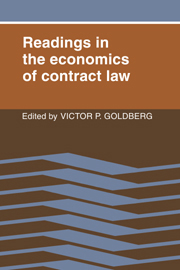Book contents
- Frontmatter
- Contents
- Preface
- Readings in the economics of contract law
- Part I Some preliminaries
- Part II Contract law and the least cost avoider
- Part III The expectation interest, the reliance interest, and consequential damages
- Part IV The lost-volume seller puzzle
- Part V Specific performance and the cost of completion
- Part VI Power, governance, and the penalty clause puzzle
- 6.1 Transaction cost determinants of “unfair” contractual arrangements
- 6.2 A relational exchange perspective on the employment relationship
- 6.3 Liquidated damages versus penalties: sense or nonsense?
- 6.4 Further thoughts on penalty clauses
- Questions and notes on power and penalty clauses
- Part VII Standard forms and warranties
- Part VIII Duress, preexisting duty, and good faith modification
- Part IX Impossibility, related doctrines, and price adjustment
- Questions and notes on impossibility and price adjustment
- References
- Index of cases
- Author index
- Subject index
6.1 - Transaction cost determinants of “unfair” contractual arrangements
Published online by Cambridge University Press: 10 November 2010
- Frontmatter
- Contents
- Preface
- Readings in the economics of contract law
- Part I Some preliminaries
- Part II Contract law and the least cost avoider
- Part III The expectation interest, the reliance interest, and consequential damages
- Part IV The lost-volume seller puzzle
- Part V Specific performance and the cost of completion
- Part VI Power, governance, and the penalty clause puzzle
- 6.1 Transaction cost determinants of “unfair” contractual arrangements
- 6.2 A relational exchange perspective on the employment relationship
- 6.3 Liquidated damages versus penalties: sense or nonsense?
- 6.4 Further thoughts on penalty clauses
- Questions and notes on power and penalty clauses
- Part VII Standard forms and warranties
- Part VIII Duress, preexisting duty, and good faith modification
- Part IX Impossibility, related doctrines, and price adjustment
- Questions and notes on impossibility and price adjustment
- References
- Index of cases
- Author index
- Subject index
Summary
Terms such as “unfair” are foreign to the economic model of voluntary exchange which implies anticipated gains to all transactors. However, much recent statutory, regulatory and antitrust activity has run counter to this economic paradigm of the efficiency properties of “freedom of contract.” The growth of “dealer day in court” legislation, FTC franchise regulations, favorable judicial consideration of “unequal bargaining power,” and unconscionability arguments, are some examples of the recent legal propensity to “protect” transactors. This is done by declaring unenforceable or illegal particular contractual provisions that, although voluntarily agreed upon in the face of significant competition, appear to be one-sided or unfair. Presentation of the standard abstract economic analysis of the mutual gains from voluntary exchange is unlikely to be an effective counterweight to this recent legal movement without an explicit attempt to provide a positive rationale for the presence of the particular unfair contractual term. This paper considers some transaction costs that might explain the voluntary adoption of contractual provisions such as termination at will and long-term exclusive dealing clauses that have been under legal attack.
The “holdup” problem
Given the presence of incomplete contractual arrangements, wealth maximizing transactors have the ability and often the incentive to renege on the transaction by holding up the other party, in the sense of taking advantage of unspecified or unenforceable elements of the contractual relationship. Such behavior is, by definition, unanticipated and not a long-run equilibrium phenomenon. Oliver Williamson [1975] has identified and discussed this phenomenon of “opportunistic behavior,” and my recent paper with Robert Crawford and Armen Alchian [1978] attempted to make operational some of the conditions under which this holdup potential is likely to be large.
- Type
- Chapter
- Information
- Readings in the Economics of Contract Law , pp. 139 - 146Publisher: Cambridge University PressPrint publication year: 1982
- 3
- Cited by



